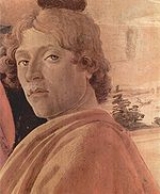
Sandro Botticelli
Overview
Alessandro di Mariano di Vanni Filipepi, better known as Sandro Botticelli (ˈsandro botːiˈtʃɛlːi) (c. 1445 – May 17, 1510) was an Italian painter of the Early Renaissance
. He belonged to the Florentine school
under the patronage of Lorenzo de' Medici
, a movement that Giorgio Vasari
would characterize less than a hundred years later as a "golden age
", a thought, suitably enough, he expressed at the head of his Vita of Botticelli. Botticelli's posthumous reputation suffered until the late 19th century; since then his work has been seen to represent the linear grace of Early Renaissance painting.
Renaissance
The Renaissance was a cultural movement that spanned roughly the 14th to the 17th century, beginning in Italy in the Late Middle Ages and later spreading to the rest of Europe. The term is also used more loosely to refer to the historical era, but since the changes of the Renaissance were not...
. He belonged to the Florentine school
Florentine School
The Florentine School refers to artists in, from or influenced by the naturalistic style developed in the 14th century, largely through the efforts of Giotto di Bondone, and in the 15th century the leading school of the world...
under the patronage of Lorenzo de' Medici
Lorenzo de' Medici
Lorenzo de' Medici was an Italian statesman and de facto ruler of the Florentine Republic during the Italian Renaissance. Known as Lorenzo the Magnificent by contemporary Florentines, he was a diplomat, politician and patron of scholars, artists and poets...
, a movement that Giorgio Vasari
Giorgio Vasari
Giorgio Vasari was an Italian painter, writer, historian, and architect, who is famous today for his biographies of Italian artists, considered the ideological foundation of art-historical writing.-Biography:...
would characterize less than a hundred years later as a "golden age
Golden Age
The term Golden Age comes from Greek mythology and legend and refers to the first in a sequence of four or five Ages of Man, in which the Golden Age is first, followed in sequence, by the Silver, Bronze, and Iron Ages, and then the present, a period of decline...
", a thought, suitably enough, he expressed at the head of his Vita of Botticelli. Botticelli's posthumous reputation suffered until the late 19th century; since then his work has been seen to represent the linear grace of Early Renaissance painting.

